Our Licensed falconers will fly trained raptors over your fields, farms, vineyards, landfills, airports, stadiums and/or any other areas with hazardous bird problems.
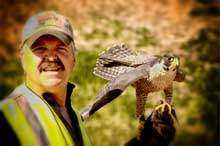 Training raptors (Birds-of-Prey) is a complex undertaking. Books containing hundreds of pages of information and advice by experienced falconers are still rudimentary at best. Many important details vary between individual raptors, species of raptors and between places and times. Unfortunately, without mentoring by an experienced falconer, raptors may be illegally taken and kept, and can be harmed by uneducated pseudo-falconers. Rather than attempt to train a raptor using only internet resources and books, it is wise to find experienced falconers and volunteer or apprentice with them. The keeping and training of any raptor is strictly and tightly regulated by U.S. state and federal laws. Anyone in the USA who is interested in flying raptors must seek out a state and federally licensed falconer to sponsor them through an apprenticeship period lasting two years at a minimum, and often considerably longer.
Training raptors (Birds-of-Prey) is a complex undertaking. Books containing hundreds of pages of information and advice by experienced falconers are still rudimentary at best. Many important details vary between individual raptors, species of raptors and between places and times. Unfortunately, without mentoring by an experienced falconer, raptors may be illegally taken and kept, and can be harmed by uneducated pseudo-falconers. Rather than attempt to train a raptor using only internet resources and books, it is wise to find experienced falconers and volunteer or apprentice with them. The keeping and training of any raptor is strictly and tightly regulated by U.S. state and federal laws. Anyone in the USA who is interested in flying raptors must seek out a state and federally licensed falconer to sponsor them through an apprenticeship period lasting two years at a minimum, and often considerably longer.
There are three styles of jesses: traditional, which is a single strap specially knotted onto the bird; and Aylmeri, a two part restraint featuring an anklet that is grommeted on, and a removable jess strap. Some Aylmeri jess straps have dental rubber bands on them to make it more difficult for the bird to pull out the jess, but they are still removable if the bird gets caught up outdoors. The third type of jesses is a combination of the two, referred to as “false Aylmeri.” These use an anklet as well, but a brass eyelet is slipped through, far enough away that the toes will not get caught in it. There are two straps attached th the anklet, flying jesses and mews jesses. Both can be removed. A good reference on these jesses is “Care And Management of Captive Raptors” by Lori Arent & Mark Martell, published by the University of Minnesota: this guide is very popular with zoos and wildlife centers, though it is not a traditional falconry book.
The singular of “jesses” is correctly “jess”, but one jess is often mistakenly called a “jessie”, by wrong back-formation from “jesses” treated as “jessies”, which would be pronounced the same.
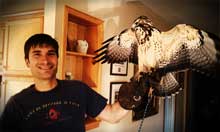
Nylon Aylmeri jesses have recently grown in popularity. Thinner, lighter, and stronger, they do not rot or need oiling to stay supple. The anklets are grommetted on, like their leather counterparts, but instead of a folded button keeping the straps from falling through the anklets, a knot is used. The end of the knot is melted with a cigarette lighter to keep it from fraying. In order to form the loops the swivel or clips will attach to, a nylon parachute cord is hollowed out, threaded up through itself using an awl, and knotted.
The swivel is to prevent tangling and twisting of the leash or tether when the bird is active but not hunting. The swivel consists of two parts that twist freely, each with a metal hoop on the end. The swivel may be traditional, or modified. The modified swivel has much larger metal hoops than the traditional. While swivels have been made of cloth or other materials in the past, most modern falconers use metal swivels. See the for more information about tying off the bird to the glove.
When using Aylmeri jesses, there are usually two sets of straps: the mews straps, for manning and tethering the bird, and flying straps. The flying straps are lighter and smaller for hunting; the mews straps are heavy and less likely to break with stress.
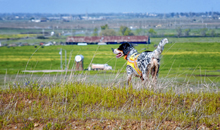 Most importantly, hunting/flying jesses do not have the slit which can often get caught on a branch or bush, leaving the bird hanging too high up in the tree to be retrieved. Since using mews jesses in the field is dangerous to the bird, educated falconers no longer risk them. Instead, they are changed out before the bird is released to fly free, and the mews jesses returned into the grommets after the free-flight is over and the bird is safely in hand.
Most importantly, hunting/flying jesses do not have the slit which can often get caught on a branch or bush, leaving the bird hanging too high up in the tree to be retrieved. Since using mews jesses in the field is dangerous to the bird, educated falconers no longer risk them. Instead, they are changed out before the bird is released to fly free, and the mews jesses returned into the grommets after the free-flight is over and the bird is safely in hand.
Jesses and anklets need to be replaced periodically, and checked for fit if they are causing injury.
A weighing scale is used to weigh the bird and its food. The scale must be reliable. This is especially important when dealing with small birds, as they may be endangered by even small weight differences when at flying weight. The successful hunting weight of the bird may vary, usually increasing as the bird is flown and develops more muscle (which weighs more than fat), but there is a relatively narrow range which the falconer seeks. Below that weight, the bird will be unnecessarily (and perhaps even dangerously) low and weak. Even the jesses laying on the scale can change the reading, so the falconer has to be careful to lift them up while the bird is being weighed. Above that range of weight, the bird will be unresponsive in the field, lacking in motivation to hunt or return to the falconer in timely fashion.
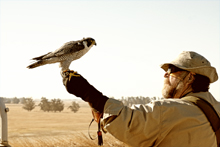 Gauntlets or gloves are used by the falconer to turn the arm into a suitable perching surface. Falconry gloves may only cover the fist and wrist, while gauntlets for larger species extend to the elbow. An eagle glove may cover the entire arm and a portion of the chest, or it may be a heavy sheath worn over a standard hawking glove. The glove will have to be replaced with wear.
Gauntlets or gloves are used by the falconer to turn the arm into a suitable perching surface. Falconry gloves may only cover the fist and wrist, while gauntlets for larger species extend to the elbow. An eagle glove may cover the entire arm and a portion of the chest, or it may be a heavy sheath worn over a standard hawking glove. The glove will have to be replaced with wear.
A creance is a long light line which is tied to the swivel or jesses. This is used only when training the bird to fly between a perch and the fist, as an assurance that the bird will not be lost in these early stages. The end away from the bird is most often wound around the spindle like a kite string; the creance can be wound or unwound with a single hand. This provides a means of storing the creance, and also provides a drag weight if the bird decides to fly off.
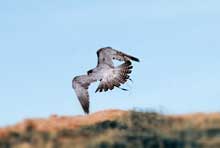 A falconry bird is usually housed in a mews. Mews in the US have to be inspected for compliance with federal and state laws. These laws ensure the that the facilities meet what is required to safely and humanely house a bird of prey. The mews (along with other perching equipment) are carefully designed to prevent bodily injury and especially feather damage. The laws and regulations generally prescribe characteristics that would allow a captive raptor some measure of security and health maintenance in the absence of an attentive experienced falconer. The mews may be used as a free-flight arrangement (especially during the summer molt or change of feathers) or it may provide a place for tethering the raptor during the night—during the day, when not actually hunting, the bird might be kept perched on a grassy lawn. Much depends on the species of raptor, the housing of the falconer, the weather, and the style of keeping, training and hunting. The less a bird is hunted, the more important the mews and domestic quarters. A falconer who likes to hunt with passage Cooper’s hawks (an American Accipiter) just for one season then release them may be content to use a spare bedroom of his/her apartment, if permitted by the state wildlife agency. Another who desires an eyass female peregrine falcon for hunting ducks on ponds and later hopes that she will lay eggs for captive breeding (long relationship, special considerations), will probably want a large special outdoor building.
A falconry bird is usually housed in a mews. Mews in the US have to be inspected for compliance with federal and state laws. These laws ensure the that the facilities meet what is required to safely and humanely house a bird of prey. The mews (along with other perching equipment) are carefully designed to prevent bodily injury and especially feather damage. The laws and regulations generally prescribe characteristics that would allow a captive raptor some measure of security and health maintenance in the absence of an attentive experienced falconer. The mews may be used as a free-flight arrangement (especially during the summer molt or change of feathers) or it may provide a place for tethering the raptor during the night—during the day, when not actually hunting, the bird might be kept perched on a grassy lawn. Much depends on the species of raptor, the housing of the falconer, the weather, and the style of keeping, training and hunting. The less a bird is hunted, the more important the mews and domestic quarters. A falconer who likes to hunt with passage Cooper’s hawks (an American Accipiter) just for one season then release them may be content to use a spare bedroom of his/her apartment, if permitted by the state wildlife agency. Another who desires an eyass female peregrine falcon for hunting ducks on ponds and later hopes that she will lay eggs for captive breeding (long relationship, special considerations), will probably want a large special outdoor building.
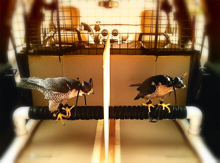 Manning
ManningManning is an essential part of falconry training that refers to the acclimation of a falconry bird to living and working with humans and things typically associated with humans, such as other pets, houses, or automobiles. The better manned a falconry bird is, the more calm and less likely to engage in fight or flight response it will be around people.
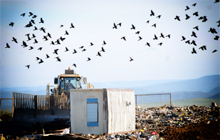 In falconry, a young, but fully-grown, raptor is trained through operant conditioning using the reward of food as a positive reinforcement. Unlike pets, raptors are non-affectionate animals, having no ability to deal with dominant or submissive roles (except the Harris’ Hawk).They do not “love” the falconer, they will not aim to please him; they are simply opportunistic and learn that life with the falconer affords the easiest and most reliable source of food and protection. Continuing the relationship, then, is a matter of convenience for the raptor. However, it is often thought there is a bondbetween bird and falconer, through which each trusts the other. The bird trusts the falconer not to steal its food and provide protection, and the falconer trusts the bird to come back.
In falconry, a young, but fully-grown, raptor is trained through operant conditioning using the reward of food as a positive reinforcement. Unlike pets, raptors are non-affectionate animals, having no ability to deal with dominant or submissive roles (except the Harris’ Hawk).They do not “love” the falconer, they will not aim to please him; they are simply opportunistic and learn that life with the falconer affords the easiest and most reliable source of food and protection. Continuing the relationship, then, is a matter of convenience for the raptor. However, it is often thought there is a bondbetween bird and falconer, through which each trusts the other. The bird trusts the falconer not to steal its food and provide protection, and the falconer trusts the bird to come back.
Many people who have not trained under a truly qualified master falconer have the impression that falconry is easy, simply fun and is an excuse to live with wild animals. The hunting partnership between a falconer and his bird is not at all like keeping a pet or a wild animal collection. Most falconers only have one or two birds, as they each require much effort. Websites or blogs featuring uninformed individuals buying several newly fledged captive bred hawks and then turning them outside to “hunt” are as far from the sport of falconry as can be imagined.
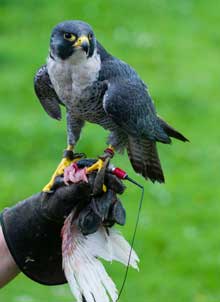 Weight is key, especially in small species. Some falconers recommend beginners start with a kestrel, a tiny species of falcon. They are ready sparrow hunters, and as they are so small one must pay close attention to their weight and training to avoid hurting them. Similarly, some falconers detest the use of Harris’ Hawks by beginners as the birds are so forgiving the novice falconer can make constant mistakes in the bird’s care and still hunt successfully. If the bird is a non-imprinted captive-bred, it is very important to establish in the bird’s mind that the falconer will facilitate hunting, and thus food. The bird will be getting accustomed to its new ‘furniture’ (equipment) as well as its new owner.
Weight is key, especially in small species. Some falconers recommend beginners start with a kestrel, a tiny species of falcon. They are ready sparrow hunters, and as they are so small one must pay close attention to their weight and training to avoid hurting them. Similarly, some falconers detest the use of Harris’ Hawks by beginners as the birds are so forgiving the novice falconer can make constant mistakes in the bird’s care and still hunt successfully. If the bird is a non-imprinted captive-bred, it is very important to establish in the bird’s mind that the falconer will facilitate hunting, and thus food. The bird will be getting accustomed to its new ‘furniture’ (equipment) as well as its new owner.
Since the success of the Harry Potter series, some novices are desperate to keep (or hunt with) an owl. Seldom does this lead to success. Many states in the U.S. provide for keeping a great horned owl for hunting, but it is a difficult venture. Owls can be a horror to hunt with, as they find prey more by hearing than their diurnal (daytime) counterparts. Even the Great Horned Owls and Eagle Owls, which can see well enough during the day, will still prefer hunting at night.
There is also greater risk to the owl when it is out during the daytime. All of the diurnal raptors see owls as mortal enemies in competition with them for food and territory. Accordingly, wild birds of prey will attack an owl mercilessly if given the opportunity, even killing it if they’re able to do so.
Laws also carefully regulate falconry in many areas. Throughout the United States, for example, the falconer will be required to pass a written exam, build facilities, have them inspected, serve a two-year apprenticeship, and keep diligent records on his or her birds. In order to catch a wild bird, the falconer may need additional licensing and permission.
Wings Over Colorado LLC
Phone: (720) 425-8968
Email @ rob@wingsovercolorado.com
Copyright © 2012 Wings Over Colorado. All Rights Reserved. Top ↑